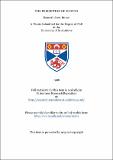Files in this item
The perception of motion
Item metadata
| dc.contributor.author | Brown, Kenneth Scott | |
| dc.coverage.spatial | 175 p. | en_US |
| dc.date.accessioned | 2018-06-26T09:04:32Z | |
| dc.date.available | 2018-06-26T09:04:32Z | |
| dc.date.issued | 1996 | |
| dc.identifier.uri | https://hdl.handle.net/10023/14581 | |
| dc.description.abstract | Extracting a motion signal for a two-dimensional contour requires the human visual system to derive a velocity vector from the spatially limited receptive fields of motion sensitive cortical cells. An individual cell's response may not specify the contour's true velocity. Models of motion often combine the outputs of different classes of receptive fields to generate a reliable motion signal. Their efficacy was tested by comparing their predictions with human psychophysical performance. The perceived speed of co-linear inclined line segments in horizontal translation was subject to a bias in favour of the local components of the contour. Single tilted lines were also subject to a bias in perceived speed. Experiments investigated the effects of grouping, co-linearity, eccentricity, terminator proximity and stimulus uncertainty on perceived speed and clearly showed that the perceived velocity of line segments is not obtained by a simple averaging process of local velocity signals and veridical velocity signals of line terminators. Variation of the spatial position of terminators was sufficient to abolish the bias in perceived speed of horizontally drifting inclined lines. Neither "vector-average" nor "winner-take-all" rules are sufficient to account for this. The method of integration of one-dimensional components into two-dimensional plaid patterns was explored in two experiments recording thresholds for perceived rotation of drifting plaids. Type II plaids are not subject to the oblique effect found for rotation discrimination thresholds for type IS plaids. Plaid rotation induced by a speed change in one of the components showed that direction perception does not follow a strict interpretation of the "intersection of constraints rule". As current models of motion integration fail to provide a full account of the perceived speed and direction of two-dimensional patterns; higher-order attentional processes should be incorporated into models of motion perception. | en_US |
| dc.language.iso | en | en_US |
| dc.publisher | University of St Andrews | |
| dc.subject.lcc | QP493.B8 | |
| dc.subject.lcsh | Movement | en |
| dc.title | The perception of motion | en_US |
| dc.type | Thesis | en_US |
| dc.type.qualificationlevel | Doctoral | en_US |
| dc.type.qualificationname | PhD Doctor of Philosophy | en_US |
| dc.publisher.institution | The University of St Andrews | en_US |
This item appears in the following Collection(s)
Items in the St Andrews Research Repository are protected by copyright, with all rights reserved, unless otherwise indicated.

